What's the blue stuff below?
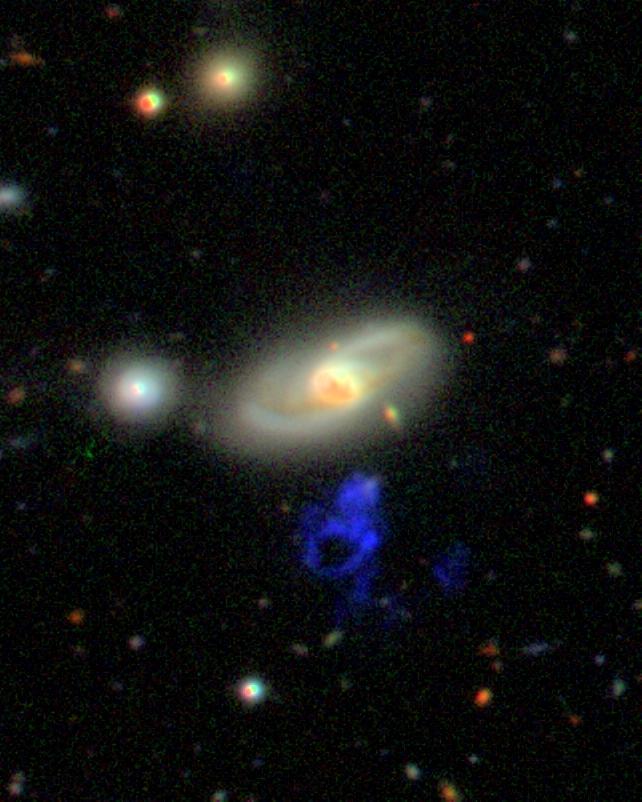
It all started with this posting:
http://www.galaxyzooforum.org/index.php?topic=3802.0
 | Author | Topic: The Hanny's Voorwerp. (Read 13845 times) |
What's the blue stuff below? Anyone? http://cas.sdss.org/astro/en/tools/chart/chart.asp?ra=145.2671505&dec=34.73290502 | |||
| |||
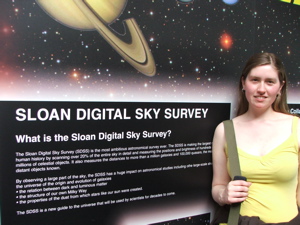
Hanny van Arkel was poring over photos of galaxies on the Internet in August 2007 when she stumbled across a strange object in the night sky: a bright, gaseous mass with a gaping hole in its middle.
Van Arkel is a 25-year-old schoolteacher in Heerlen, The Netherlands, not an astrophysicist. But her startling find -- a mysterious and unique object some observers are calling a "cosmic ghost" -- has captivated astronomers and even caught the attention of the people who run the Hubble Space Telescope, who have agreed to take a closer look next year.
"This discovery really shows how citizen science has come of age in the Internet world," said Bill Keel, professor of physics and astronomy at the University of Alabama and a Galaxy Zoo team member. "There was a time when I spoke pejoratively of armchair astronomers. And I've gotten up at a star party and publicly apologized for that."
Not so long ago, the term "amateur astronomer" conjured images of stargazers peering through backyard telescopes. But today's are as likely to be analyzing reams of sophisticated data collected by observatories and posted on space-related Web sites.
Armchair observers like van Arkel increasingly are making significant contributions to science, said Steve Maran, spokesman for the American Astronomical Society, a group of 6,500 professionals. Amateurs have been invited to present papers at recent AAS conferences, "which wouldn't have happened years ago," he said.
A successful example of amateur-professional collaboration, the Galaxy Zoo project was launched last year by Yale University astrophysicist Kevin Schawinski and Chris Lintott at the University of Oxford in England.
The pair were looking for help in cataloging archived photographs of galaxies -- one million images -- taken by the robotic Sloan Digital Sky Survey telescope in remote southern New Mexico.
Knowing that the human eye is sometimes more sensitive than a computer at picking out unusual patterns -- and that they didn't have time to do all the work themselves -- Schawinski and Lintott posted the images on the Galaxy Zoo Web site last summer.
The professors then invited amateur astronomers, with the help of a brief online tutorial, to classify the galaxies as spiral, elliptical or something else. Online galaxy-sorting might not sound as fun as, say, surfing YouTube, but it was an immediate hit.
"We were overwhelmed by the response. It completely melted the server," Schawinski said. "People tell us it's addictive. Some of [the volunteers] are professional astronomers, but most of them are not. They're just regular people who got excited about the project."
During the past year, more than 150,000 armchair astronomers from all over the world volunteered their time, submitting more than 50 million classifications.
The public's collective wisdom -- the same principle that guides jury trials or Wikipedia -- proved remarkably astute, Schawinski said. For example, if 33 of 36 volunteers thought a galaxy appeared elliptical, then astronomers could be confident the classification was correct, he said.
Van Arkel had been classifying photos on Galaxy Zoo for about a week when she came across the image that quickly became known as "Hanny's Voorwerp," Dutch for "object." The primary school teacher does not own a telescope -- "my [astronomy] background doesn't really go further than looking at the stars when walking outside in the evening," she said -- but when she posted her finding August 13 on the Galaxy Zoo forum, the astronomers who run the site began to investigate.
They soon realized van Arkel might have found a new class of astronomical object. The Galaxy Zoo team asked scientists working at telescopes around the world to take a look at the mysterious Voorwerp.
Their best guess: The Voorwerp is probably a cloud of hot gas punctured by a central hole 16,000 light years across and illuminated by the "dying embers" of a nearby quasar, Schawinski said. Quasars are distant, highly luminous astronomical objects powered by black holes; scientists suspect that light from the quasar still illuminates the Voorwerp even though the quasar itself burned out in the past 100,000 years.
"It's this light echo that has been frozen in time for us to observe," said Lintott, the Oxford scientist. "It's rather like examining the scene of a crime where, although we can't see them, we know the culprit must be lurking somewhere nearby in the shadows."
Galaxy Zoo leaders are eagerly awaiting images from NASA's orbiting Hubble, which is scheduled to train its powerful instruments on the Voorwerp in 2009. In the meantime, van Arkel is enjoying the fuss over her contribution to astronomy.
"It's amazing to think that ... amateur volunteers can help by spotting things like this online," she said. "What excites me the most is that all of this leads to more interest in science."
Our working hypothesis is that Hanny's Voorwerp consists of dust and gas (maybe from a tidally disrupted dwarf galaxy) which is illuminated by a quasar outburst within IC 2497, an outburst which has faded dramatically within the last 100,000 years. More details on why we think so can be found in some entries in the Galaxy Zoo blog: January 18, on the first spectral data; January 31, as we got more images; and March 20, as we started to piece together this whole picture.
Explanation: What is that green thing? A volunteer sky enthusiast surfing through online Galaxy Zoo images has discovered something really strange. The mystery object is unusually green, not of any clear galaxy type, and situated below relatively normal looking spiral galaxy IC 2497. Dutch schoolteacher Hanny van Arkel, discovered the strange green "voorwerp" (Dutch for "object") last year. The Galaxy Zoo project encourages sky enthusiasts to browse through SDSS images and classify galaxy types. Now known popularly as Hanny's Voorwerp, subsequent observations have shown that the mysterious green blob has the same distance as neighboring galaxy IC 2497. Research is ongoing, but one leading hypothesis holds that Hanny's Voorwerp is a small galaxy that acts like a large reflection nebula, showing the reflected light of a bright quasar event that was visible in the center of IC 2497 about 100,000 years ago. Pictured above, Hanny's Voorwerp was imaged recently by the 2.5-meter Isaac Newton Telescope in the Canary Islands by Dan Smith, Peter Herbert and Chris Lintott (Univ. Hertfordshire). Other collaboration members include Matt Jarvis, Kevin Schawinski, and William Keel.

Nearly a year ago, astronomers at several universities recruited citizen scientists to help them catalog distant galaxies that had recently been photographed as part of the Sloan Digital Sky Survey. A high-school physics teacher in the
That novelty appears to be a quasar whose intense radio emissions have been fueling star births.
Alex Szalay of
In the process, it collected more data than astronomers decided they could ever realistically review and catalog. So they released more than a million never-before-seen images for the public to peruse in the comfort of their own homes. After a bit of online training, each was asked to categorize the type or shape of galaxies in any image they viewed.
“We expected to get several hundred people a day” taking part, Szalay says. In fact, the first day alone there were several million. During the past 11 months, the public has turned in some 40 million galaxy classifications. But the one that has astronomers scratching their heads is the Dutch report of a weird blue object, or Voorwerp. A teacher named Hanny reported the mystery cloud on a Galaxy Zoo blog in mid-August and asked if anyone knew what it might be.
Her request didn’t really catch the eye of scientists until around Christmas, Szalay says. Since then, astronomers have been abuzz over the enigmatic object. They’ve also been filing requests to get viewing time on major telescopes in coming months for a better look.
What initially slowed an evaluation of Hanny’s Voorwerp was that “we didn’t have a spectrum for it, so it could have been literally anywhere from right next door in our galaxy to the edge of the universe,” explained Kevin, another Galaxy Zoo blogger, on Jan. 31. A helpful colleague, astronomer Bill Keel of the
Piecing together odd bits about that galaxy, the newfound object’s spectra, and some additional crisp imaging of the region, Keel concluded: “The Voorwerp is at almost exactly the same redshift [or distance] as IC 2497, and almost certainly associated with it.” The object’s intense and narrow range of blue emissions, he said, “are what one would see from a star-forming region. But there are some things about it that are strange, and need more work.” Moreover, he added, “Whatever this is, it’s rare.” Galaxy zookeeper Chris Lintott of
Szalay says Lintott has now formally drafted a proposal to use the Space Telescope, together with Keel to study the Voorwerp. “And we just got a notification, about a week ago,” Szalay told me, “that we’re getting seven orbits [to do this], which will be scheduled at some time in the fall.”
Szalay says other preliminary observations with an ultraviolet satellite have been completed, and Keel has asked to use the Very Large Array radio telescope near
Currently, no one is sure what the wispy blue cloud is. But Szalay says it appears to be “radiation emitted by a quasar.” Only one similar object is known, he says: Minkowski’s object.
I’d never heard of it before. But googling the name turned up descriptions suggesting Minkowski’s Voorwerp is a stellar nursery — incubating some 10 million stars. This conglomeration is thought to have formed when a jet of intense radio waves slammed into a patch of dense gas. The source of the radio jet: a black hole at the core of a nearby galaxy (NGC 541).
It’s not yet known whether the new Voorwerp is the same thing, “but it has similarities,” Szalay says.
Whatever it turns out to be, he says the enterprise that uncovered it “blew my mind. You read in the papers that today people are not interested in science.” But the number of GZ recruits, or zooties, confirm that much of the public is not only interested in science, he says, but willing to take part in it.
“This is different from running something on your computer, like SETI@home or the prime-number search,” he maintains. GZ requires that nonscientists actually use their brain power. Not only can this armchair astronomy be fun, he says, but participants "can make a genuine discovery” — as Hanny did.
Look for formal announcements on the new, blue, Minkowski-like object soon from both the zookeepers and Johns Hopkins.
May 14, 2008
Another Zoo meetup, and a Zoo celebrity meets some of the team
We’ve all read the story of Hanny’s Voorwerp, and about two weeks ago we were lucky enough here in the UK to have the Voorwerp’s discoverer come and visit us again, meeting some of the team and catching up with some fellow volunteers at another Galaxy Zoo meetup. On her first day here, Hanny first visited some of the Zoo members here at the Institute of Cosmology and Gravitation in Portsmouth, workplace of Zoo team members Daniel, Steven and Bob (and of course myself). After meeting some of the team, Hanny got an invitation to join the meeting the observational group at the ICG has each week to tell us about the discovery of the Voorwerp, and so that everyone could get an update from Daniel on the latest goings on on that front. There’s a lot of interest from all the astronomers here, not just those already working on Galaxy Zoo.
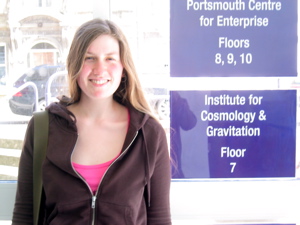
On Saturday, myself and Hanny travelled up to Winchester to visit the INTECH science centre and planetarium, catching up with many other Zoo volunteers and our forum moderator Alice. You can catch up on the many photos and happenings on the forum thread for the meetup! The centre’s notable for having an exhibit based on SDSS, the survey from which Galaxy Zoo gets its images.

We took Sunday as an opportunity to travel up to Oxford - here’s Hanny and Zookeeper Kevin together! The social side of Galaxy Zoo is clearly still going strong, and more meetups are already being planned in the forums.
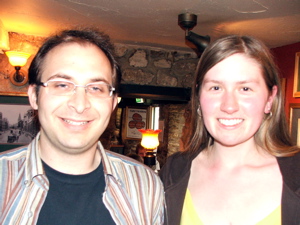
Other examples of REFLECTION NEBULA:

(IC 349) in Pleiades


Trifidnebula (Messier-Object M20, NGC 6514)

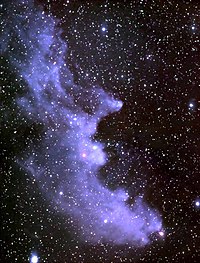
In Astronomy, reflection nebulae are clouds of dust which are simply reflecting the light of a nearby star or stars. The energy from the nearby star, or stars, is insufficient to ionize the gas of the nebula to create an emission nebulae, but is enough to give sufficient scattering to make the dust visible. Thus, the frequency spectrum shown by reflection nebulae is similar to that of the illuminating stars. Among the microscopic particles responsible for the scattering are carbon compounds (e. g. diamond dust) and compounds of other elements such as iron and nickel. The latter two are often aligned with the galactic magnetic field and cause the scattered light to be slightly polarized (Kaler, 1998). Edwin Hubble distinguished between the emission and reflection nebulae in 1922.
Reflection nebulae are usually blue because the scattering is more efficient for blue light than red (this is the same scattering process that gives us blue skies and red sunsets).
Reflection nebulae and emission nebulae are often seen together and are sometimes both referred to as diffuse nebulae. An example of this is the Orion Nebula.
Some 500 reflection nebulae are known. Among the nicest of the reflection nebulae are those surrounding the stars of the Pleiades. A blue reflection nebula can also be seen in the same area of the sky as the Trifid Nebula. The giant star Antares, which is very red (spectral class M1), is surrounded by a large, red reflection nebula.
 Stumble It!
Stumble It!


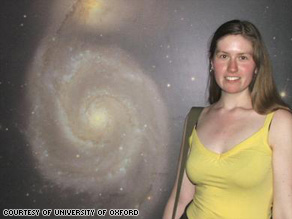
0 Comments:
Post a Comment
<< Home